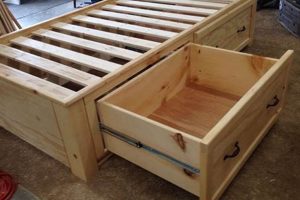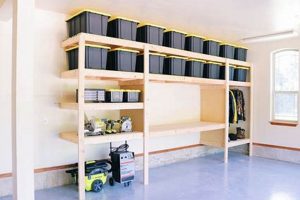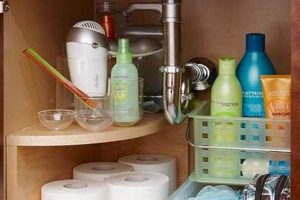The practice of constructing personalized receptacles for waste containers represents a tangible solution to mitigate visual clutter and potential olfactory issues associated with refuse disposal. These custom constructions, typically undertaken as home improvement projects, offer a discreet enclosure for standardized trash bins, effectively concealing them from view and reducing the likelihood of pest intrusion. For instance, a homeowner might build a wooden structure with hinged doors to house recycling and garbage bins, enhancing the aesthetic appeal of their property.
The significance of these projects extends beyond mere aesthetics. Well-designed enclosures contribute to property value by improving curb appeal and preventing unsightly waste from detracting from the overall appearance. Historically, the need for organized waste management solutions has prompted innovation in container design and storage methods. Effective concealment also minimizes the risk of scavenging animals accessing the contents, thereby contributing to neighborhood sanitation and preventing the spread of diseases. Furthermore, these constructions can safeguard bins from inclement weather, preventing damage and ensuring the longevity of the containers.
The subsequent discourse will examine diverse construction methods, material selection considerations, design adaptations for varying spatial constraints, and practical implementation guidelines for fabricating effective and visually cohesive solutions to contain and manage household waste.
Essential Considerations for Waste Container Concealment
The following outlines critical guidance to ensure the successful construction and implementation of a waste container enclosure. Adherence to these guidelines promotes functionality, durability, and aesthetic integration with the surrounding environment.
Tip 1: Accurate Measurement is Paramount: Before commencing construction, meticulously measure the dimensions of the waste containers to be housed. Account for sufficient clearance to facilitate easy insertion and removal of the bins, preventing binding or obstruction.
Tip 2: Material Selection for Longevity: Choose durable, weather-resistant materials appropriate for the local climate. Pressure-treated lumber, composite decking, or galvanized steel offer increased resistance to moisture, decay, and insect infestation, extending the lifespan of the structure.
Tip 3: Adequate Ventilation is Crucial: Incorporate ventilation openings within the design to mitigate odor buildup and prevent moisture accumulation. Strategically placed vents promote airflow, reducing the likelihood of mold growth and unpleasant smells.
Tip 4: Secure Latching Mechanisms: Implement robust latching mechanisms to secure the enclosure doors or lids. This prevents unauthorized access by animals or children and ensures that the containers remain contained during inclement weather events, such as high winds.
Tip 5: Consider Accessibility Requirements: Design the enclosure with user accessibility in mind. Ensure that the lid or door mechanisms are easily operable and that the interior space allows for convenient maneuvering of the waste containers, particularly when full.
Tip 6: Aesthetic Integration with Surroundings: Select a design and finish that complements the existing architectural style and landscaping. Harmonious integration enhances the overall aesthetic appeal of the property and prevents the enclosure from becoming an eyesore.
Tip 7: Compliance with Local Regulations: Research and adhere to all applicable local ordinances and building codes regarding waste container storage. Failure to comply with regulations may result in fines or required modifications.
Implementing these tips ensures the resulting waste container concealment solution is functional, durable, and aesthetically pleasing, contributing to improved property value and neighborhood sanitation.
The subsequent sections will delve into specific design methodologies and advanced construction techniques to further optimize the effectiveness of waste container enclosure projects.
1. Material Durability
Material durability is a cornerstone of successful construction projects intended to conceal waste containers. The selection of materials directly influences the longevity, maintenance requirements, and overall cost-effectiveness of the enclosure. Degradation due to environmental factors necessitates replacement, increasing both financial burden and time investment. Therefore, selecting robust materials is paramount.
- Weather Resistance
Exposure to precipitation, sunlight, and temperature fluctuations degrades many materials. Untreated wood rots, while some metals corrode. Selecting materials inherently resistant to these elements, such as pressure-treated lumber or powder-coated steel, is critical. For example, using cedar wood, known for its natural resistance to decay and insect damage, minimizes the need for frequent repairs or replacements. The failure to prioritize weather resistance results in premature structural failure.
- Pest Resistance
Waste receptacles attract pests. Enclosures constructed from materials susceptible to insect infestation, such as untreated wood, become breeding grounds for vermin, compromising structural integrity. Utilizing pest-resistant materials, such as composite lumber, mitigates this risk. For instance, a composite enclosure effectively prevents termite damage, which would otherwise necessitate costly repairs or complete reconstruction.
- Structural Integrity Under Load
Enclosures must withstand the weight of the containers and potential external forces, such as wind or snow. Insufficient structural integrity leads to warping, cracking, or collapse. Employing materials with high strength-to-weight ratios, such as steel framing or reinforced concrete, ensures stability. A steel-framed enclosure, for instance, can withstand significant wind loads, preventing damage and ensuring containment during storms. The omission of adequate load-bearing capacity risks structural failure.
- Resistance to Impact and Abrasion
Daily use involves moving containers in and out of the enclosure, potentially causing impact and abrasion. Materials prone to scratching or denting degrade aesthetically and functionally. Selecting materials with high impact resistance, such as recycled plastic lumber, minimizes wear and tear. An enclosure constructed from recycled plastic, for instance, can withstand repeated impacts from container movement without showing significant signs of damage, preserving its appearance and functionality.
The long-term success of self-constructed waste container enclosures hinges on the diligent selection of materials that withstand environmental degradation, pest infestation, structural stress, and physical wear. Investing in durable materials from the outset significantly reduces maintenance requirements, extends the lifespan of the enclosure, and ultimately contributes to a more cost-effective and aesthetically pleasing waste management solution.
2. Spatial Efficiency
Spatial efficiency represents a critical factor in the design and implementation of do-it-yourself waste container storage solutions. Optimizing the use of available space is particularly relevant in urban environments and properties with limited square footage, necessitating strategic approaches to container placement and enclosure construction.
- Footprint Minimization
Reducing the ground area occupied by the enclosure maximizes usable space within the property. Compact designs, such as vertical storage solutions or corner placements, minimize intrusion into gardens, walkways, or driveways. An example includes a narrow, vertical enclosure situated against a property line, conserving valuable yard space. The implication is increased functionality of the outdoor area while maintaining necessary waste storage capacity.
- Internal Volume Optimization
Efficiently utilizing the internal volume of the enclosure ensures adequate storage capacity without unnecessary bulk. Customized shelving or dividers can accommodate multiple containers of varying sizes, maximizing the storage potential within a limited space. An example involves tiered shelving to house both standard trash bins and smaller recycling containers within a single enclosure. This configuration facilitates organized waste separation within a minimized footprint.
- Adaptable Configurations
Designs that adapt to irregular spaces or existing landscape features enhance spatial efficiency. Enclosures can be custom-built to conform to corners, slopes, or other spatial constraints, optimizing otherwise unusable areas. An example includes an enclosure built into a sloped portion of a yard, integrating the structure with the terrain and minimizing disruption to the natural landscape. The outcome is a seamless integration of waste management with the existing environment.
- Multi-Functional Integration
Combining the enclosure with other functional elements, such as planters or seating, further optimizes spatial utilization. An enclosure integrated with a built-in planter box provides dual functionality, enhancing aesthetic appeal while maximizing space utilization. An example is a structure that incorporates a bench seat along one side, offering both waste concealment and a seating area. This approach transforms a purely functional element into an integrated part of the outdoor living space.
These facets of spatial efficiency, when thoughtfully integrated into the construction of DIY waste container storage, yield solutions that are both practical and aesthetically pleasing. Careful consideration of footprint, volume, adaptability, and multi-functional integration ensures that waste management solutions complement, rather than detract from, the usability and visual appeal of the property.
3. Odor Control
Effective odor control is a fundamental consideration in the design and implementation of self-constructed waste container enclosures. Uncontrolled odors emanating from decomposing waste present a nuisance and potential health concern, necessitating proactive measures to mitigate their dispersion.
- Ventilation Strategies
Strategic ventilation facilitates the dissipation of volatile organic compounds (VOCs) generated during waste decomposition. Ventilation openings, strategically positioned to promote airflow, reduce the concentration of odor-causing compounds within the enclosure. For instance, incorporating screened vents near the top and bottom of the structure encourages convection currents, continuously exchanging stale air with fresh air. Inadequate ventilation results in a buildup of unpleasant smells, attracting pests and impacting the surrounding environment. Ventilation is essential to proper odor management.
- Material Selection Considerations
Certain materials exhibit inherent odor-absorbing properties, contributing to odor mitigation. The use of cedar wood, known for its aromatic oils, masks the smell of decaying waste. Incorporating activated carbon filters within the ventilation system further reduces odor emissions by adsorbing VOCs. An example involves lining the interior of the enclosure with cedar planks to reduce odors. Failure to consider the odor-absorbing properties of materials exacerbates the problem of uncontrolled odors.
- Containment Integrity
Ensuring the structural integrity of the enclosure prevents the escape of odors into the surrounding environment. Tight-fitting doors or lids, coupled with weather stripping, minimize gaps through which odors can escape. Sealing seams and joints with a suitable sealant further prevents leakage. A well-sealed enclosure effectively contains odors, preventing them from impacting nearby residents or businesses. Compromised containment leads to the dispersal of unpleasant smells, negating the benefits of other odor control measures.
- Waste Management Practices
Implementing proper waste management practices within the enclosure minimizes the generation of odors. Regular cleaning of the interior surfaces, coupled with the use of odor-absorbing powders or sprays, reduces the accumulation of odor-causing bacteria. Sorting waste to separate organic materials from non-biodegradable items reduces the rate of decomposition and associated odor production. Employing biodegradable trash bags minimizes environmental impact. Improper waste management practices negate the effectiveness of even the most sophisticated odor control mechanisms.
Successful odor control within self-constructed waste container enclosures necessitates a multifaceted approach, encompassing strategic ventilation, judicious material selection, robust containment, and responsible waste management. Integrating these elements into the design and maintenance of the enclosure effectively minimizes odor emissions, contributing to a cleaner and more pleasant environment.
4. Accessibility
Accessibility, in the context of personalized waste receptacle construction, denotes the ease and convenience with which users can interact with the storage solution. Design considerations extending beyond mere containment directly impact the usability and efficiency of waste disposal processes.
- Lid Operation Mechanisms
The design of lid or door mechanisms directly influences user experience. Heavy or cumbersome lids requiring excessive force to open impede accessibility. Solutions incorporating spring-assisted hinges, gas struts, or lightweight materials mitigate this issue. For instance, a hinged lid supported by a gas strut allows for effortless opening and closing, particularly beneficial for individuals with limited strength. The presence of malfunctioning or poorly designed mechanisms renders the enclosure less usable.
- Container Retrieval and Placement
The ease with which waste containers can be removed and replaced within the enclosure is paramount. Insufficient clearance or awkward configurations hinder this process. Implementing features such as pull-out shelves or ramps facilitates smooth container movement. An example includes a pull-out shelf enabling users to effortlessly slide containers out for emptying, minimizing strain and potential injury. Limited space increases the difficulty associated with this necessary task.
- Height and Reach Considerations
The height of the enclosure and the reach required to access the containers must accommodate a range of user abilities. Excessively high structures pose challenges for shorter individuals or those with mobility limitations. Designing enclosures with lower profiles or adjustable shelving ensures accessibility for a wider user base. An example includes an enclosure with adjustable shelf heights, accommodating users of varying stature and reach. Failure to accommodate these considerations restricts usability.
- Clear Pathways and Maneuvering Space
Unobstructed pathways leading to the enclosure and sufficient maneuvering space around it are essential for accessibility. Obstacles such as uneven terrain, narrow walkways, or overgrown vegetation impede access. Ensuring a clear, level pathway allows for safe and convenient disposal of waste. For example, a paved walkway leading directly to the enclosure, free from obstructions, enhances accessibility for all users, including those using mobility aids. Limited space causes difficulty in reaching the location and interacting with its design and usability.
These elements of accessibility, when thoughtfully integrated into the planning and execution of personalized waste receptacle projects, create solutions that are not only aesthetically pleasing but also user-friendly. Prioritizing ease of use ensures that waste management processes are efficient, safe, and inclusive for all members of the household.
5. Aesthetic Integration
Aesthetic integration, within the framework of constructing personalized waste container enclosures, signifies the harmonious blending of the structure with its surrounding environment. This facet extends beyond mere functionality, acknowledging the visual impact of a waste management solution on the overall aesthetic of the property. Disregarding this element results in a visually discordant addition, detracting from the property’s curb appeal and potentially diminishing its perceived value. An example is a brightly colored, utilitarian structure incongruously placed within a landscape characterized by muted tones and natural materials, creating a jarring visual effect. The consequence is an unsightly feature that undermines the property’s aesthetic cohesion. Therefore, considering aesthetic integration is paramount.
Effective aesthetic integration necessitates careful consideration of several factors. Color palettes should complement existing architectural elements and landscaping features. Material selection should align with the prevailing design themes of the property. Furthermore, the overall design should incorporate elements that soften the visual impact of the structure, such as incorporating planters, trellises, or textured surfaces. For instance, an enclosure constructed from reclaimed wood, stained to match existing fencing, and incorporating a climbing vine would seamlessly blend with a rustic garden setting. Conversely, failure to harmonize the structure with its surroundings results in a visually obtrusive element that detracts from the property’s overall aesthetic appeal. A gray enclosure may blend in with dark stone, or a white enclosure may look better with a light-colored home. Consider the color and shade of the surrounding areas and select an appropriate product.
Ultimately, the successful aesthetic integration of waste container enclosures transforms a purely functional necessity into an enhancement of the property’s visual appeal. Thoughtful design and careful material selection yield a solution that not only conceals unsightly waste receptacles but also contributes positively to the overall aesthetic harmony of the outdoor space. This integration is challenging, and can be difficult, but will enhance the properties appearence. By prioritizing aesthetic integration, homeowners can ensure that their waste management solutions are both practical and visually appealing, contributing to increased property value and improved neighborhood aesthetics.
6. Security
The integration of security measures into self-constructed waste receptacle containment is a crucial aspect often overlooked. The implications of neglecting security extend beyond simple aesthetics, encompassing issues of identity theft, public safety, and environmental protection. A robust design should incorporate features that mitigate these potential risks.
- Protection Against Identity Theft
Discarded documents containing personal information are a prime target for identity theft. Implementing a locking mechanism on the enclosure restricts unauthorized access to sensitive materials awaiting disposal. For instance, a secure latch or padlock deters opportunistic individuals from rifling through refuse in search of personal data. The omission of such security measures facilitates identity theft, exposing individuals to financial and personal risk.
- Prevention of Hazardous Material Access
Household waste often contains potentially hazardous materials, such as discarded medications or cleaning products. A secure enclosure prevents unauthorized access by children, pets, or individuals with malicious intent. For example, a lockable cabinet within the enclosure can isolate hazardous waste, preventing accidental ingestion or misuse. Failure to secure hazardous materials poses significant health and environmental risks.
- Mitigation of Vandalism and Arson
Waste receptacles are vulnerable to vandalism and arson, posing a threat to property and public safety. A robust enclosure constructed from durable materials, coupled with a secure locking mechanism, deters malicious acts. For instance, an enclosure constructed from metal sheeting with a secure latch prevents vandals from setting fire to the contents or damaging the structure. Neglecting to safeguard against vandalism increases the risk of property damage and potential injury.
- Deterrence of Illegal Dumping
Open or easily accessible waste receptacles attract illegal dumping, burdening homeowners with the responsibility of disposing of others’ waste. A secure enclosure prevents unauthorized disposal, maintaining the cleanliness and aesthetic appeal of the property. For instance, a locked enclosure prevents individuals from dumping unwanted items, such as construction debris or bulky waste, on the property. The absence of security measures encourages illegal dumping, leading to increased costs and potential environmental contamination.
These security considerations, thoughtfully integrated into waste container construction, offer multifaceted protection against identity theft, hazardous material exposure, vandalism, and illegal dumping. Prioritizing security not only safeguards personal information and public safety but also contributes to a cleaner, more secure community.
Frequently Asked Questions
The following addresses common inquiries concerning the construction and implementation of personalized waste receptacle containment solutions. This information aims to provide clarity and address potential concerns.
Question 1: Is obtaining a building permit necessary for constructing a waste container enclosure?
Building permit requirements vary significantly by jurisdiction. Consult with local authorities to determine if a permit is required based on the size, location, and structural characteristics of the proposed enclosure. Failure to obtain necessary permits may result in fines or mandatory modifications.
Question 2: What is the recommended distance between the enclosure and the property line?
Local zoning regulations typically dictate setback requirements for structures, including waste container enclosures. Adhere to these regulations to avoid potential conflicts with neighboring properties and ensure compliance with municipal ordinances.
Question 3: How can the accumulation of rainwater within the enclosure be prevented?
Incorporate a slightly sloped roof design to facilitate water runoff. Implement drainage openings at the base of the enclosure to prevent water accumulation. Consider using water-resistant materials to minimize potential damage from moisture exposure.
Question 4: What security measures are recommended to prevent unauthorized access?
Install a locking mechanism on the enclosure doors or lids to deter unauthorized access. Consider using tamper-proof hardware to prevent vandalism or forced entry. Implement motion-activated lighting to enhance security and deter potential intruders.
Question 5: What is the best method for cleaning the interior of a waste container enclosure?
Regular cleaning with a disinfectant solution helps prevent odor buildup and bacterial growth. Utilize a pressure washer to remove accumulated debris and grime. Ensure adequate ventilation during and after cleaning to facilitate drying and prevent mold formation.
Question 6: How can the enclosure be protected from damage caused by rodents or insects?
Construct the enclosure from pest-resistant materials, such as pressure-treated lumber or metal sheeting. Seal any gaps or openings to prevent rodent or insect entry. Consider using traps or repellents to deter pests from inhabiting the enclosure.
Adherence to these recommendations promotes the longevity, functionality, and security of constructed waste receptacle solutions. Addressing these common concerns ensures a more effective and satisfactory outcome.
The subsequent article section will examine case studies and real-world examples of successful containment projects, illustrating practical application of the principles outlined herein.
Concluding Remarks on Waste Container Concealment
This exploration of diy trash bin storage has traversed the critical considerations involved in constructing effective and aesthetically pleasing waste management solutions. From material durability and spatial efficiency to odor control, accessibility, security, and aesthetic integration, the discourse has underscored the multifaceted nature of this seemingly simple undertaking. The preceding analysis illuminated common challenges, provided actionable guidance, and emphasized the importance of adhering to local regulations.
The construction of personalized waste receptacle enclosures represents more than mere concealment; it embodies responsible waste management practices and enhances the aesthetic character of residential properties. Thoughtful planning and diligent execution result in solutions that contribute to cleaner communities and improved environmental stewardship. The principles outlined herein provide a foundation for informed decision-making and successful project implementation, fostering both functionality and visual harmony in waste management practices. Future innovations may refine material science, enhance security protocols, and improve sustainability, but the core objective will remain: responsible, aesthetic, and secure waste containment.




![Build Your Own! Storage Bin Rack DIY Project [Easy] The DIY Hub: Creative Crafts, Repairs & Life Hacks Build Your Own! Storage Bin Rack DIY Project [Easy] | The DIY Hub: Creative Crafts, Repairs & Life Hacks](https://craftingdiycenter.com/wp-content/uploads/2025/07/th-1825-300x200.jpg)


